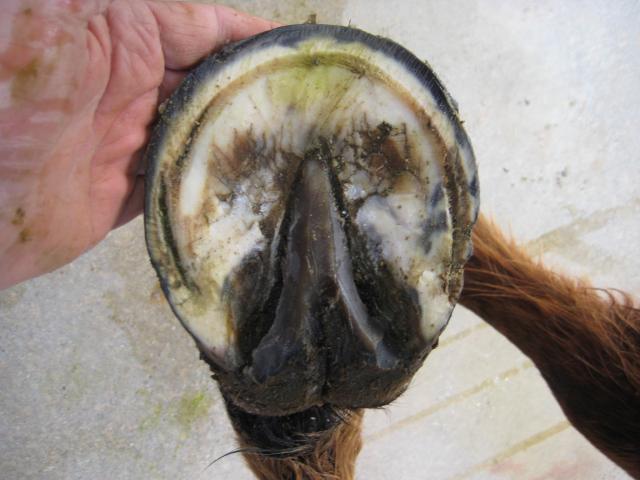This is the first issue in a mini series on hoof capsule distortions, short HCD.
During these blogs, we’ll examine the reasons why the occur, how we identify them, what we can do to correct them, which horse hoof trimming to apply and finally, how the glue on Horseshoes can help in the whole process.
Today we want to look at hoof wall flares. Flare can occur for a variety of reasons. Some are:
1. The horse’s leg is not centered over the hoof.
2. The horse is narrow or wide based
3. Hooves are turned in or out
4. Shelly hoof wall
5. Bacterial invasion in laminae
6. Inflammation of laminae
7. Trimming intervals are too long.
As we see, there are a variety of reasons for flares. The common denominator for flares is simply: improper loading.
Flares are created by stretching and tearing of horn tubules. With enough stress through stretching, the laminae cannot take the stress and begin to tear. Bacteria then invade, further weakening the laminae. In a flared hoof, the energy of loading will be transferred obliquely across the horn tubules, instead of in line with the tubules. A flared hoof wall has a very limited amount of strength. It cannot function properly in the way of absorbing concussion, storing and releasing energy. In fact, the longer we leave flares, the greater the potential damage with bacterial infection, followed by the destruction of the laminae.
What can we do about it? Obviously we cannot change the conformation of our horses. Some horses are always prone to develop flares. However, we can help by shortening trimming intervals, applying barefoot trimming methods, bevelling the hoof wall after a trim and paying close attention to the medial/lateral balance.
Flares need to be removed by top dressing the hoof wall. Most farriers and hoof care practitioners follow the rule of thumb of not removing more than half the thickness of the hoof wall. Farriers want enough hoof wall left to hold the nails and clinches. There is also an argument that the hoof capsule is weakened by removing more than half the thickness of the hoof wall and therefore cannot not support the load anymore.That makes some sense, but doesn’t solve the problem. We still have hoof wall separation and we still have a weakened hoof wall. It’s not the thickness of the hoof wall that we are concerned with, much more important is the health of the laminae. With a weakened laminae, it doesn’t matter how thick your hoof wall is, the hoof capsule won’t be able to support the loading.
I believe in rasping all the flares off, even if I have to take it down to the white line at the quarters. Thus the hoof wall is now straight and is allowed to regrow. The stress is removed, the laminae can heal. Best to use a Hoof Jack for the rasping. Much easier on your back.
Now we are coming to the essence of it all; Protective Horse Boots.
The EasyCare Glue Ons are like a hoof capsule reinforcement. It almost doesn’t matter how thin the hoof wall might be at the quarters or dorsally, the Glue ons, together with the glue create an additional artificial layer of a hoof wall, strengthening the thinner areas and holding the hoof capsule together. There might be uneven loading, the hoof might load more medial or more distal, the Glue on Horseshoes mitigate this problem tremendously. Since using glue on horse shoes, I have seen a remarkable reduction in flares. Laminaes are healthier, no bacterial invasion through the nail holes anymore.
Below are some images of flares.

Dorsal view of the untrimmed hoof, flared

Before the trim; take note of the weakening of the laminae medial and distal

After trimming, before removing flares. Notice the destruction of the laminae at the quarters

After flare removal

Dorsal view after top dressing the flares

Left hoof: View of the sole after top dressing the flares

Right hoof: after top dressing the flares, the wall at the quarters are pretty thin. That is okay, though. See text above.
That’s it for today. Next time, we are discussing dorsal HCD
So long,
Your Bootmeister




